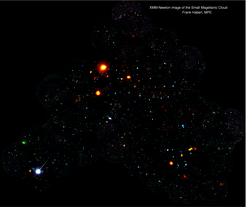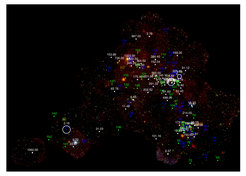The Small Magellanic Cloud
The Small Magellanic Cloud (SMC) is a gas-rich irregular dwarf galaxy and the second-nearest star forming galaxy after the Large Magellanic Could. Recent star formation was triggered by tidal interactions between the two galaxies and with the Milky Way. Because of the relatively short distance of about 60 kpc and low Galactic foreground extinction and absorption the SMC is an ideal target for population studies of objects which are not always accessible in the Milky Way. Understanding the emission components of nearby galaxies is required to understand the unresolved emission from more distant galaxies.

Full XMM-Newton, EPIC PN+MOS mosaic image of the SMC region including all observations available as of December 2013. The red, green and blue images are produced from ata in the energy bands 0.2-1.0 keV, 1.0-2.0 keV and 2.0-4.5 keV. The images are detector-background subtracted, exposure and vignetting corrected (and out-of-time event subtracted for PN). The image shows many point sources, extended supernova remnants and large-scale diffuse emission.

The numerous HMXBs known in the SMC marked on the EPIC mosaic image from above. The pulsars are labeled with their pulse periods in seconds. High-confidence HMXBs without known spin period are marked in green and other candidates in blue. The size of the circles scales with the positional uncertainty.

